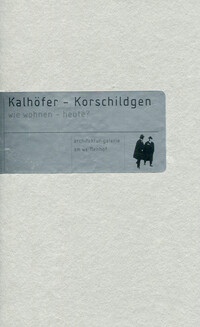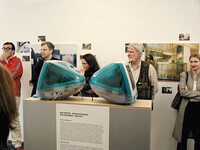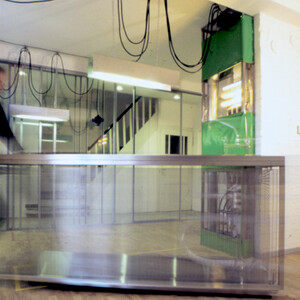

Exhibition, how do you live today?: Always and everywhere
Today we live in a constantly changing society, which is characterized by compression and expansion. Time and space are occupied more intensively in “always and everywhere ”1. “Always” stands for the condensation of time through activity, “Everywhere” for the expansion of mobility. This results in an expansion of the possibilities in the space-time structure, combined with the dissolution of existing boundaries and the replacement of unambiguity by ambiguity. Our way of life and the world of objects around us are affected - in public as well as in private space. We leave the rigid ties of familiar milieus and switch between different working environments. Our everyday products are characterized by accelerated reactions to changed consumer wishes and serve increasingly complex user requirements. Everyone wants more today: we want different things to be available simultaneously in a situation and enjoy the freedom of decision.
Either … or
The classic architectural design process, on the other hand, is first and foremost a simplification model. It is about thinning rather than enrichment: one situation is distinguished from another and ultimately the apparently better one is preferred. Variants are used to determine the optimum. It is about establishing a binding state: “Either or” is the principle, optimization stands in the way of the option.
As well … as
The architecture of “as well as” is about the complexity of living through the availability of different rooms in one place. We deal with the “changeable” and want to dissolve the boundaries of the classic space with its “frozen forms and uses”. In this way we provide a multi-layered offer so that the diversity, contradictions and ambiguities of social life can be reflected in living. We are against the purism of aesthetic constriction and want an architecture of the user, not that of a final form. Our goal is a space of assembly that can be shaped by the user and that can change from one state to the other at will. We are therefore interested in an optional architecture of dynamics and evolution.
Living is never finished
The architecture designs the apartment towards its final state. However, the apartment is not an aesthetic object of admiration or symbolic representation, it is a daily instrument for the animation / housing of the room, is a catalyst for possibilities for action. Our projects rarely stipulate a clear sequence of rooms or organizations, but rather offer a functionally and formally open system. For us, it is the “unfinished” that makes the whole possible for the resident. We want a living space that goes beyond the result of the constructed object, that includes the potential and targets areas outside of one’s own existence. For us, at the end of architecture there is a beginning. According to Alain Guiheux, there are two architectures: “those that derive their quality from physical reality and those who derive their quality from what they enable.” also formally open system. Housing is never finished. The current action in space defines.
Optional rooms
For us, space is both: shell and space. The shell determines the function and mood - with it we fix technical and space-creating infrastructures that support the possibilities in the space. The elasticity of the shell makes the quantitative relationship between adjacent rooms variable. The temporary dissolution of the outer shell creates an ambivalent space for sensual indoor and outdoor experience. The space belongs to the user and is a dynamic, flexible zone. It is a “transactional” space in which the relationships between the shell used and the occupant are in constant feedback over a period of time3. Our residential projects are about “optional” use. We design room for maneuver for appropriating and adapting the space in between. In all projects we try to break up the usual fixation of connections between space, function and formal statement or object and use through new, unexpected combinations of parts of the living space and to set them in motion. It is about preventing the monotonous, the everyday, the functional bondage and the fixed expectations of living. By anchoring the option, the same room prompts new or different uses. Living should be experienced again and again by the user. Psychologically, the option model means an exemption for the user. An open space contains the potential for a variety of actions. The decisive factor is not only the constant, actual use of the options, but the serenity that arises when one has potential options for variation. At the same time, the optional space promotes a distance-free relationship between architecture and users. Anyone who can move their house back and forth loses their submissive attitude towards the aesthetics of their own home and experiences a sensuality of use that is not only useful, but also fun. For us, the design of living is a tightrope walk between openness and fixation. First of all, the design is an exact reflection of all the demands and constraints of the task. Clear statements must be made. However, the demands of users in terms of living are constantly changing: the target group grows or shrinks over time. Room sequences change with changes in use. Unclear requirements during the planning phase require the floor plan to be kept open after completion, so that the final solution can be tried out in the reference phase. The living space must include long-term or short-term variables. For us, however, changes in living space are not a neurotic “non-stop” of a disjointed acceleration society that no longer knows a beginning and an end. We suggest a possible “rhythm” for each option: Seasons, temperature changes, day / night changes, or we develop medium-term cycles for change of location, change of atmosphere or function. Rhythm creates a familiar relationship between space and time for the user. Because the intervals of change remain explainable, it conveys the feeling of constancy within the changeability. The rhythm is the restructuring of the spatially unstructured space through time and the cyclical time takes on the necessary orientation standard in the liberated, hierarchical space. This standard of orientation is order and free flow at the same time.
Spaces of perception
We reject neutral structures for generating variable uses. These lead to the dissolution of perceptible differences through uniformity - and, according to Richard Sennett - to the monotony of our cities in terms of interchangeability, flexibility enables.4 We want spaces that create concrete atmospheres and still allow changeability. The philosopher Gernot Böhme describes in his book “Appearances - About the Atmospheric” 5 that we first notice its atmosphere in a room before we have deciphered it morphologically. The apartment is not only a field of activity, but also a container of different atmospheres. In this sense, the option model for us is not just the offer of a functionally objective alternative, as it was in the 1960s, but also that of a changing appearance. Our projects are always about the question of what they generate, because for us spaces are spaces of perception. A living space that changes cannot be explained immediately. It loses its defining character, becomes interpretable and acquires a visual depth effect. For the resident, the perceived, real and possible future space is synthesized in the imagination and transferred into a floating state of visual ambiguity that goes beyond the real. Visible and potential space merge, or as Jean Baudrillard says: “A successful space is a space that exists beyond one’s own reality.” 6
1 Karlheinz A. Geißler: Die Orientierung am Rhythmus; in: Zeit, Zeitverständnis in Wissenschaft und Lebenswelt; Rusterholz, Moser, Bern 1997
2 Alain Guiheux: Architecture Action, Sens&Tonka, Paris, 2002
3 Hans Joachim Harloff: Zur Grundlegung der Wohnpsychologie, Report Psychologie 5.1989
4 Richard Sennett: Interview mit Ralf Berhorst, Süddeutsche Zeitung, 4.4.2000
5 Gernot Böhme: Anmutungen - Über das Atmosphärische, Ed. Tertium, Ostfildern, 1998
6 Jean Baudrillard: Architektur: Wahrheit oder Radikalität, Literaturverlag Droschl, Graz 1999







